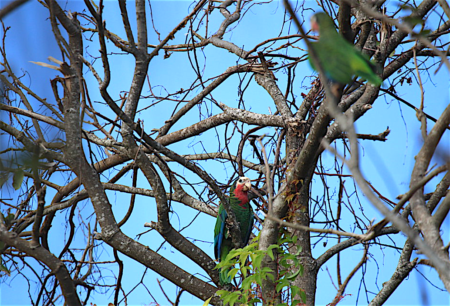
It is almost two months since a Category Five Hurricane named Dorian completely devastated the islands of Grand Bahama and Abaco from September 1 to 3. Here is what has been happening since BirdsCaribbean sent out an online appeal for emergency funding to help birds and restore habitats on these islands. If you have not already done so, please consider donating even a small amount. There is much work still to be done, and Bahamian birds and nature will be grateful!
Still a Long Way to Go
Media reports have made it clear: life has by no means returned to normal on the islands. Many lives have been lost. Many residents have lost everything and are homeless. A large number have left the islands to seek a new life elsewhere.
Meanwhile, what needs to be taken into consideration, as rebuilding starts? This is up for debate. At BirdsCaribbean, when the time comes we hope that reconstruction will take place on an equitable basis, taking into account the need for coastal resiliency and habitat restoration. In other words, the environment takes priority.
What We Have Done So Far
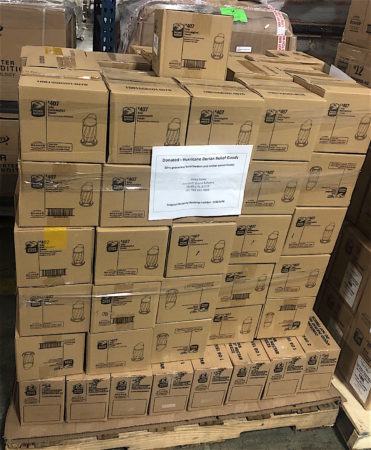
Thanks to the generosity of our supporters, we are pleased to report that contributions are going directly to restoration and long-term planning efforts across both islands. As we reported in our first update, 2,000 pounds of bird seed, 300 tube seed feeders, 400 nectar feeders, and nectar concentrate (enough to make 1,900 gallons) are currently being distributed in Grand Bahama (items are also been sent to Abaco). We will be sharing an update on which communities received supplies and the results of the feeding effort shortly. See a photo essay report on the first bird survey conducted on the East End of Grand Bahama on October 3rd, one month after Hurricane Dorian lingered over the area for 3 full days.
We also reached out to our valued partners at Bahamas National Trust (BNT) with essential new equipment. These include cameras, binoculars, a drone, iPad, GPS equipment, rangefinders, compasses, backpacks and other equipment vital for field survey work.
Our Partners Have Been Out in the Field
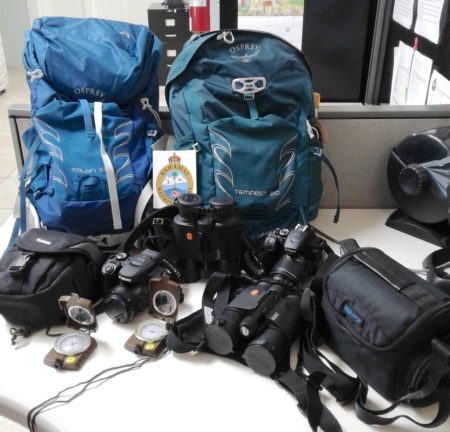
Armed with the equipment they received from BirdsCaribbean, our colleagues at BNT did not waste any time. They went straight out into the field to assess the impacts of the storm on wildlife. Your support is helping to cover the cost of Rapid Assessment Field studies. A team from BNT and Audubon Florida just completed an initial 5-day survey of Abaco focused on the Bahama Parrot (also known as the Abaco Parrot) and its habitat.
Our partners found that conditions on the island of Abaco varied widely. In southern Abaco, both humans and birds appeared to be recovering and spirits were positive. Life was going on, homes were in relatively good condition, stores and bars were open and a fuel station at Sandy Point was open for business. Common bird species such as House Sparrows and Cuban Pewees appeared unaffected by the storm’s impact.
The northern part of the island painted a very different picture – a very sad picture. Many trees and buildings were destroyed. Older trees had lost their leaves or were severely damaged, losing limbs and bark. They were just beginning to sprout small leaves and shoots.
Getting Down to Work
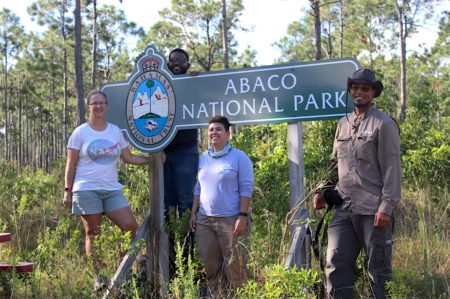
The team got organized. They divided up tasks, in order to get as much done as possible in a short space of time.
Abaco Parrot researcher Caroline Stahala Walker (Audubon) and Bradley Watson (BNT Science Officer) worked on vegetation surveys. Occasionally, they were joined by David Knowles (BNT, Chief Park Warden, Abaco National Park), who had lost his own home in the hurricane, but is still continuing to work; along with Marcus Davis, the BNT Deputy Park Warden, whose home further south remained intact.
Giselle Deane (BNT Assistant Science Officer) and Ancilleno Davis (Blue Lagoon Island and BirdsCaribbean Board member) collected the bird survey data using the binoculars and rangefinders BirdsCaribbean was able to provide, thanks to the emergency funds raised. Visual records are vitally important. Bradley Watson used his new camera provided by BirdsCaribbean to take plenty of photograph of birds, plants, and habitats throughout.
Will Abaco’s Parrots Recover?
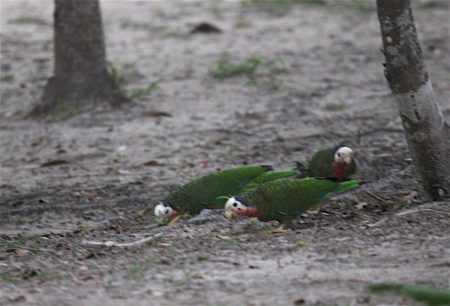
It was disturbing to see the birds foraging in the dirt for fallen fruit at a resort development in central Abaco, while a cat prowled around nearby. The parrots’ usual habit is to only eat the freshest fruit directly from the trees, dropping small portions on the ground. Abaco’s population of the Bahama Parrot is also especially vulnerable since they nest in rock cavities on the ground.
But all is not lost. The team found small flocks of Bahama Parrots flying in Abaco. They are making themselves heard again across the island. The team put out supplemental food stations, to help the parrots survive during this critical period of food shortages.
It’s not clear, however, whether prospects for the parrots are encouraging in the long term. This is because the destruction of large parts of the birds’ habitat in central and northern Abaco means that food will remain in short supply. While the researchers remain cautiously optimistic, it is clear that a much wider effort to restore foraging habitat will be needed to help sustain the parrot population year-round and outside of the breeding season, which is May/June.
A Mixed Picture
The survey team will soon be releasing a full report on their findings on Abaco. There is much more work to be done, and the post-hurricane period is critical for the welfare of the birds and indeed all wildlife on these devastated islands.
Meanwhile, human residents are still picking up the pieces – in some cases literally – and many challenges remain.
PHOTO GALLERY – Hover over each photo to see the caption, to see a slide show click on the first photo.
Sincere thanks to all who have donated so generously to our Hurricane Dorian Recovery Fund! We will continue provide updates on our work to help restore birds and habitats and help local partners like the Bahamas National Trust with recovery work on Abaco and Grand Bahama.












Thank you for this detailed and informative report of the survey. I picked up some of the details at the time – it’s good to have such a clear overview. The parrot reports are happily increasing as are the flocks numbers. And from the shorelines, counts in the last few days produced unexpectedly good numbers of piping plovers on their usual beaches… and these include some of this year’s pre-Dorian banded resights now back on their same beaches. RH
Thank you, Keith, for this comment and additional feedback about Piping Plovers being back, this is great news indeed! All the best, Lisa Sorenson